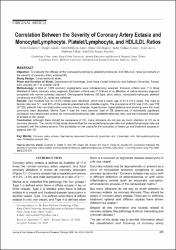| dc.contributor.author | Özdemir, Emre | |
| dc.contributor.author | Şafak, Özgen | |
| dc.contributor.author | Altın, Mert Pehlivan | |
| dc.contributor.author | Akgün, Didar Elif | |
| dc.contributor.author | Emren, Sadık Volkan | |
| dc.contributor.author | Avcı, Eyüp | |
| dc.contributor.author | Tokaç, Mehmet | |
| dc.contributor.author | Akyıldız, Filiz Akçay | |
| dc.date.accessioned | 2021-04-05T10:49:25Z | |
| dc.date.available | 2021-04-05T10:49:25Z | |
| dc.date.issued | 2020 | en_US |
| dc.identifier.issn | 1022-386X | |
| dc.identifier.issn | 1681-7168 | |
| dc.identifier.uri | https://hdl.handle.net/20.500.12462/11388 | |
| dc.description | Şafak, Özgen (Balikesir Author) | en_US |
| dc.description.abstract | Objective: To evaluate the efficacy of the monocyte/lymphocyte, platelet/lymphocyte, and HDULDL ratios as markers of the severity of coronary artery ectasia(CE).
Study Design: Cross-sectional study.
Place and Duration of Study: Department of Cardiology, Izmir Katip Celebi University and Balikesir University, Turkey, from January 2017 to October 2018.
Methodology: A total of 7,923 coronary angiographs were retrospectively scanned. Inclusion criteria was >1.5 times dilatated of native coronary artery segment. Exclusion criteria was <1.5 times or no dilatation of native coronary segment compared with normal coronary segment. Demographic features, CE type, clinic status, monocyte/lymphocyte, platelet/lymphocyte and HDULDL ratios are collected.
Results: Two hundred and six (2.6%) cases were identified, which had a mean age of 61.4 111.4 years. The male to female ratio was 3:1; and 46% of the patients presented with unstable angina. The prevalence of CE was 2.6%; and 118 (57.2%) patients had non-obstructive coronary artery disease. Hypertension, hyperlipidemia and smoking were the most commonly seen disorders. Markis Type 4 was the most common type of CE determined. A statistically significant correlation was determined among the monocyte/lymphocyte ratio, platelet/lymphocyte ratio, and the increased diameter of ectasia of the vessel.
Conclusion: Although there should be awareness of CE, many clinicians do not pay as much attention to CE as to coronary stenosis. The results of this study showed that the monocyte/lymphocyte ratio and platelet/lymphocyte ratio are consistent with the ectasia severity. This correlation will be useful for the evaluation of follow-up and treatment success in patients with CE. | en_US |
| dc.language.iso | eng | en_US |
| dc.publisher | Coll Physicians & Surgeons Pakistan | en_US |
| dc.rights | info:eu-repo/semantics/openAccess | en_US |
| dc.subject | Coronary Artery Ectasia | en_US |
| dc.subject | High-Density Lipoprotein/Low-Density Lipoprotein Ratio | en_US |
| dc.subject | Lipoprotein Ratio | en_US |
| dc.subject | Monocyte/Lymphocyte Ratio | en_US |
| dc.subject | Platelet/Lymphocyte Ratio | en_US |
| dc.title | Correlation between the severity of coronary artery ectasia and monocyte/lymphocyte, platelet/lymphocyte, and HDL/LDL ratios | en_US |
| dc.type | article | en_US |
| dc.relation.journal | JCPSP-Journal of the College of Physicians and Surgeons Pakistan | en_US |
| dc.contributor.department | Tıp Fakültesi | en_US |
| dc.contributor.authorID | 0000-0001-8245-0117 | en_US |
| dc.identifier.volume | 30 | en_US |
| dc.identifier.issue | 3 | en_US |
| dc.identifier.startpage | 235 | en_US |
| dc.identifier.endpage | 239 | en_US |
| dc.relation.publicationcategory | Makale - Uluslararası Hakemli Dergi - Kurum Öğretim Elemanı | en_US |


















